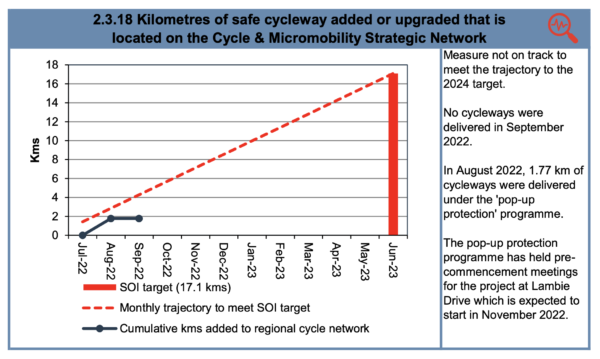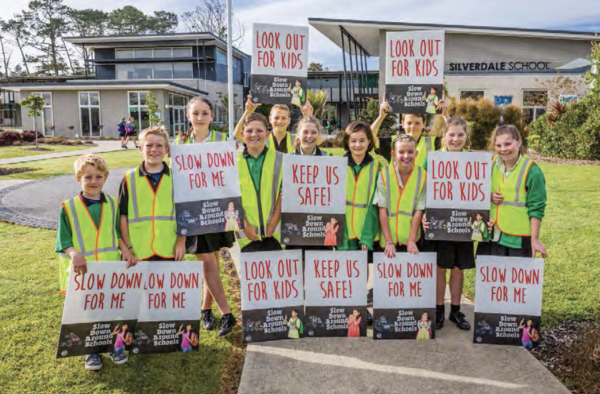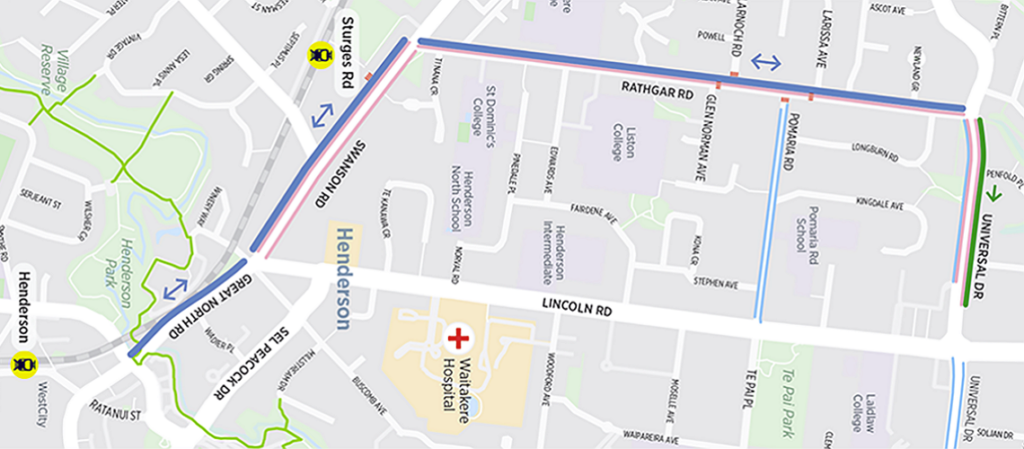On Thursday the Auckland Transport board meets for the last time this year, and also the first time since the council new council was sworn in.
It’s unclear if they’ll even have a quorum for the meeting. Chair Adrienne Young-Cooper resigned immediately after the council elections, and Tommy Parker resigned at the start of this month. Yesterday another board member, Jim Mather, resigned leaving just five current, members which isn’t enough.
Of course, Auckland council has just appointed councillors Mike Lee and Andy Baker to the board – but Thursday is also the inaugural meeting of council’s new Transport and Infrastructure Committee so it’s unclear which meeting they’ll attend.
Assuming the meeting goes ahead, here are some of the interesting things on the agendas.
Note: Recent meetings have also been conducted on Microsoft Teams with the public able to join and watch the open session, but it doesn’t appear they’re doing that this time. Why not?
Especially as the board papers repeatedly mention the impacts of Covid on access to various transport options, surely they can extend this insight to their own processes and build confidence by letting everyone observe good transport governance in action?
Closed Agenda
The closed agenda is often where the most interesting papers are, and there are quite a few of them this meeting.
Items for Approval
- Advertising and Procurement presentation – I suspect a theme we’re going to see more of in coming years is AT trying to eke out every bit of revenue they can. Could this mean more advertising in more places that AT have control over?
- Public Transport Fare Review – It’s not clear if this means AT staff are pushing for fares to change, but given that AT are struggling for revenue as a result of reduced PT use and that costs have increased, it wouldn’t surprise me if they’re looking to put up fares. If this does happen, it typically happens in mid-February – which means it would land at the same time as the government removing the 50% fare discount, which is due to happen at the end of January.
This is likely to have quite a negative impact on perception of PT, at a time when we need many more people using it. This is likely to be compounded by the appalling quality of service AT have been providing, with thousands of services cancelled every week as well as the negative impacts of rail network closures.
(It’s worth noting that AT is slow to raise prices in other areas: some on-street parking prices haven’t changed in over five years, and places like the city centre are coming up on four years unchanged.) - Internal Audit Plan – This stuff is typically pretty dry, but I wonder if AT plans to start auditing programmes where a lot of money is being spent with almost nothing to show for it, like Connected Communities? Or will they audit the appalling pace of delivery of cycleways, which has to be becoming a reputational risk?

Items for Noting:
- NZ Police Deployment Dashboard and Enforcement Activities – A lack of enforcement has been one of the significant factors behind deaths and serious injuries on our roads so hopefully this means more is being done about it.
- Van Schaik Business Improvement Review (BIR) Report
- Relationship Management Approach
- Waka Kotahi Update on transport funding challenges – whose funding challenges? Central government’s, or Auckland’s?
- Funding Challenges for Auckland Transport – presumably is this in the light of Council’s projected budget shortfall. If AT’s looking for projects to put on ice or reexamine, we’ve covered a few.
- Update on Climate Emergency Relief Fund (CERF) Applications (for approval) – Hopefully we see some great projects come out of this. One big CERF funding opportunity is the $350m Transport Choices fund, which is aimed at “a range of transport services and infrastructure that will help the uptake of active and shared travel options to reduce people’s reliance on travelling by car.” Applications were due in September and delivery has a “very ambitious two-year timeframe”. Is AT ready?
- Governance of Reputation Management – see all of the above.
Business Report
Here are the items in the open business report that caught my attention. Also, there is still no new permanent Chief Executive for Auckland Transport, with Shane Ellison having announced his resignation about a year ago now. What’s going on there?
Customer Service
AT notes that customer service staffing levels are 10% below their “sustainable operating needs“. This presumably means a lot more pressure on remaining staff.
There’s this comment about the displays around the PT network. I certainly hope they work to fix the way buses are shown, it’s absurd the displays scroll through buses that are hours away rather than just the next services for each route that uses that bus stop.
The Customer Services Group has facilitated a heightened focus on our Passenger Information Displays (PIDs) in the PT network following a lift in negative feedback from customers on faults and time to fix them. AT is working to improve the operational performance of these 850+ PIDs through a combination of renewals, new displays, more proactive remote monitoring to ensure displays are ‘online’, and a program to improve b interface that supports the service information feeds
Slow Down Around Schools Campaign
In a section about this campaign, which includes bus backs, bus shelters, and radio ads, and ramps up at the start of every school term, they say:
- The message to Slow Down appears to come from the tamariki themselves which we know resonates with Aucklanders when it comes to general support of safe speeds.
- The campaign complements the work that the Community Transport team are doing with schools such as students holding “Slow down” placards at the start of school terms and a speed maths activity where they measure speeds people travel at around their school to help create school and community messages.
Of course it’s good to remind people to slow down around schools, and the speed management programme is increasingly installing 30kmh zones around schools. But is AT actually measuring speeds around schools to see if this campaign is having any effect, and/or are they mainly getting the kids and schools to do the work?

Community Connect Concessions
The government are currently planning to end the half priced fares package at the end of January and the next day, the Community Connect scheme will start. That will give Community Service Card holders a 50% discount on most PT services.
AT says it is being applied on HOP cards as a concession in the same way SuperGold card concessions are, rather than a via needing a separate card. This is an odd way of describing it, as SuperGold requires a dedicated HOP card rather than just being able to load up any HOP card.
Around 300,000 Aucklanders are eligible for the concession, and AT have started sending out emails and letters to get them to start loading the concessions now.
RPTP
AT say they’ve started work on the next Regional Public Transport Plan (RPTP), a statutory document that lays out how public transport will be developed and what services will be run. They say they’ll be seeking early input from transport operators, project partners, advocates and key stakeholders in December 2022 with formal public consultation in mid-2023.
I’m guessing this is where we’ll finally hear what the plans are for services on the rail network post-CRL, as well as formalising the planned improvements to buses as part of Phil Goff’s Climate Package.
Henderson Network
In talking about their recent consultation for a cycleway on Rathgar Rd and part of Swanson Rd, AT says:
An initial public consultation held earlier last year showed that Swanson/Rathgar Road was the most preferred route after Lincoln Road, which was ruled out due to cost and complexity.
This is interesting, as they’ve never said before that Lincoln Rd was ruled out, or that safe cycling is subject to cost and complexity. In fact, in the Henderson consultation they said:
This route will eventually connect to cycling facilities that are planned for future Lincoln Road Improvements.
If they have already ruled out future safe cycling on Lincoln Rd, which is where a lot of shops and other amenities are located, you have to wonder if they consulted in good faith?

Also, coming back to the topic of AT getting the kids to do the work, they note:
During this consultation period we run a number of community information sessions, met with local Businesses and worked extensively with local school students, including Liston college students who created an NCEA Unit to better understand the project and collect and analyse data about pedestrian movements, parking and cycling.
Again, great to involve communities in understanding how evidence-based policy is created, but is this backed up inside the organisation? And can it be used to shut down objections to safety programmes that harp on about the “cost” to adults of slowing down around schools?
Property
In a section about Property Optimisation I noticed this comment. It’s the first time I’ve heard about the Papatoetoe Second Rail Crossing project and give all that land wouldn’t be needed for a
major roof repairs estimated to cost approximately $0.8m are required on AT’s largest asset in the portfolio – 49 Station Road, Papatoetoe – held for the Papatoetoe Second Rail Crossing. The property returns net revenue of $0.45m per annum.
This is the site in question:

Cycling and micromobility
One thing I keep an eye on in the Transport Indicators report is cycling and micromobility counts, especially as the public reporting has been lax and only recently caught up after a gap of several months.
Numbers are still down on 2019, which AT attributes to “increased working from home and ongoing [?] Covid restrictions”. Most of AT’s counters are on the longer-distance cycling routes, which isn’t really providing a full picture of who’s cycling and where. It doesn’t pick up cycling to school, for example.
So you have to ask, three years into the pandemic why isn’t AT deploying counters in neighbourhoods to detect whether all that “increased working from home” is leading to more local cycling? Tracking local trips would also help provide a fuller picture of who and where their “customers” are as well.
Speaking of local areas, the report mentions in passing the three Inner West projects that have been raised by Councillor (and new board member) Mike Lee, as covered by our friends at Bike Auckland recently.
These projects are imminently due to commence after years of consultation and redesign, were all funded under National’s Urban Cycleways Programme back in 2015, and one (Great North Road) has come under the wing of Connected Communities. The Business Report notes:
- Waitematā Safe Routes aka Grey Lynn is 90% through detailed design, due to be completed by end of November, with resource consent from Council expected early December, and construction able to commence from April 2023 onwards.
- Great North Road enabling works are listed under contracts let, and JFC Limited has already begun on this advance work. Hopefully the main contract isn’t far behind.
- Pt Chev to Westmere is listed under RLTP funding, with Waka Kotahi having approved $37.61m towards this work, which includes a full rebuild of Meola Road to address subsidence and protect from future flooding. Good, given its built on landfill and carries a lot of buses and cars.
Also excellent to see the Glen Innes projects confirmed as under way, every part of town deserves safe links for biking and scooting and maybe this will help AT’s delivery graph look better at next year’s board meetings.

If you’ve looked through the reports, is there anything else that stands out? I also noted mention of the TERP, and Climate Governance, interested to hear your thoughts on this.
The next meeting is not till 28 February 2023, three months away. That’s a gap of a full quarter before the governors and Council will formally check in again on how this CCO is doing with meeting its mandates.
Thinking ahead, what’s likely to be top of that agenda? What will the balance of faces look like around the board table? And will AT have a confirmed CEO by then?

 Processing...
Processing...
How on earth are Council and AT still scheduling their governance meetings in the same timeslot?
Yeah, it shouldn’t be that hard to schedule this on one of the 20 or so other available days in the month!
The current fare levels are good value, attractive and where they should have been all along. Any attempt to increase the base fare structure coninciding with the end of the half fares will be disastrous.
SuperGold actually doesn’t require a different card. The gold card was a policy thing but there are many regular blue cards out there with supergold concession loaded.
Agree, My original Blue Card was allocated a Gold Concession.
In terms of transport funding,l can see no reason to continue with the fuel tax reduction and the RUC subsidy. The Govt ,through the Reserve Bank, are “taxing” the general public,with higher interest rates,yet are happy to forgo income from fuel tax. IMO,the Reserve Bank could just as easily use the price of fuel and RUC,to curb inflation,as they do with interest rates.
Agree entirely. Subsidising fossil fuels makes us look like a third world country. I would be accept a contingent the subsidy if the max road speed was reduced to a more fuel efficient 80kmph.
You have a chance to ask for max 80 km/h in a consultation open until 12 December. https://www.nzta.govt.nz/safety/what-waka-kotahi-is-doing/interim-state-highway-speed-management-plan/
It’s not one of the options offered, though.
Actually, there are no options on offer.
In my region (Manawatū–Whanganui) WK could only find 12 km out of 1000 km of state highway that need their speed limit lowered, and then only from 100 km/h to 90 km/h.
Of course their plan does need to be approved by the Director of Land Transport, who is… a member of the WK board. All sounds a bit circular to me.
Interesting idea. Raise prices on an input to almost every sector with taxes to try and reduce the general price level. Not sure that will work. Maybe if they dropped the price of fuel and RUCs by the amount everything else increased perhaps that might work.
There are two trains of thought. Firstly you can argue that ‘subsidizing’ road fuel through lowering direct taxes sustains demand, at a time when rising global oil prices need measures to erode demand. High price is the only demand destruction tool available to Governments, so they should do this as part of measures to curb inflation. On the other side of the coin, many countries (NZ included) have large distances between populated areas and poor public transport options. It is these rural communities that especially suffer high fuel prices and Rangi from the East Cape shouldn’t suffer because of some woke tossers in Auckland (well that is how the people suffering fuel poverty see it).
Personally, I would have retained the taxes on fuel and used the revenue to help those hit hardest, including increasing foreign aid to Ukraine.
100% increase in fares plus extra increase on top of that and sh.. service on top of that? Well, good luck. I think in February PT in Auckland will officially die. They’ve tried to kill it for a long time and now they will finally succeed.
At least keep the $10 daily cap.
“No new permanent Chief Executive”
How do you reconcile that any new CEO is so important we need to pay them $500k or more
But we can also do without them for a year or so, as they apparently aren’t that critical to the operation of the organization.
“aren’t that critical to the operation of the organization.”
Or the old one didn’t do the job right, and the lack of one hasn’t improved things. The bar is low, and only cars can pass easily under it at the moment.
Maybe they need a CEO to tell them to fix the escalators at Henderson station.
Sorry, as instructed by Wayne Brown, AT have to concentrate more on people who have to or want to drive. As escalators can not be used by cars, your request is now st the back of the priority queue (the deleted emails folder)
So that’s where Scott Campbell is working now. Closed item 16 has him as “Interim Executive General Manager, Stakeholder,Communities and Communication”
“… it wouldn’t surprise me if they’re looking to put up fares….
(It’s worth noting that AT is slow to raise prices in other areas: some on-street parking prices haven’t changed in over five years, and places like the city centre are coming up on four years unchanged)”
Yes, good point, they better not put PT fares up.
> Waka Kotahi having approved $37.61m towards this work, which includes a full rebuild of Meola Road to address subsidence and protect from future flooding
That will be chalked up to the cycling budget no doubt.
Orsman certainly keeps acting like the whole cost of any street upgrade project is a cycling cost. Its about the same level of dishonest reporting as if someone was reporting the cost of the mayoral office as if it was the mayor’s salary. Of course he wouldn’t do that. No. Just things he dislikes.
Papatoetoe second crossing sounds interesting. Can’t find anything online, but it doesn’t look like it would be easy to connect to Shirley Rd on the other side. Google maps shows what looks to be a designated corridor from the end of Portage Rd to 46 Swaffield Rd. But an underpass from Hospital Rd to Gray Ave would be about the midpoint, and probably require the least amount of earthworks.